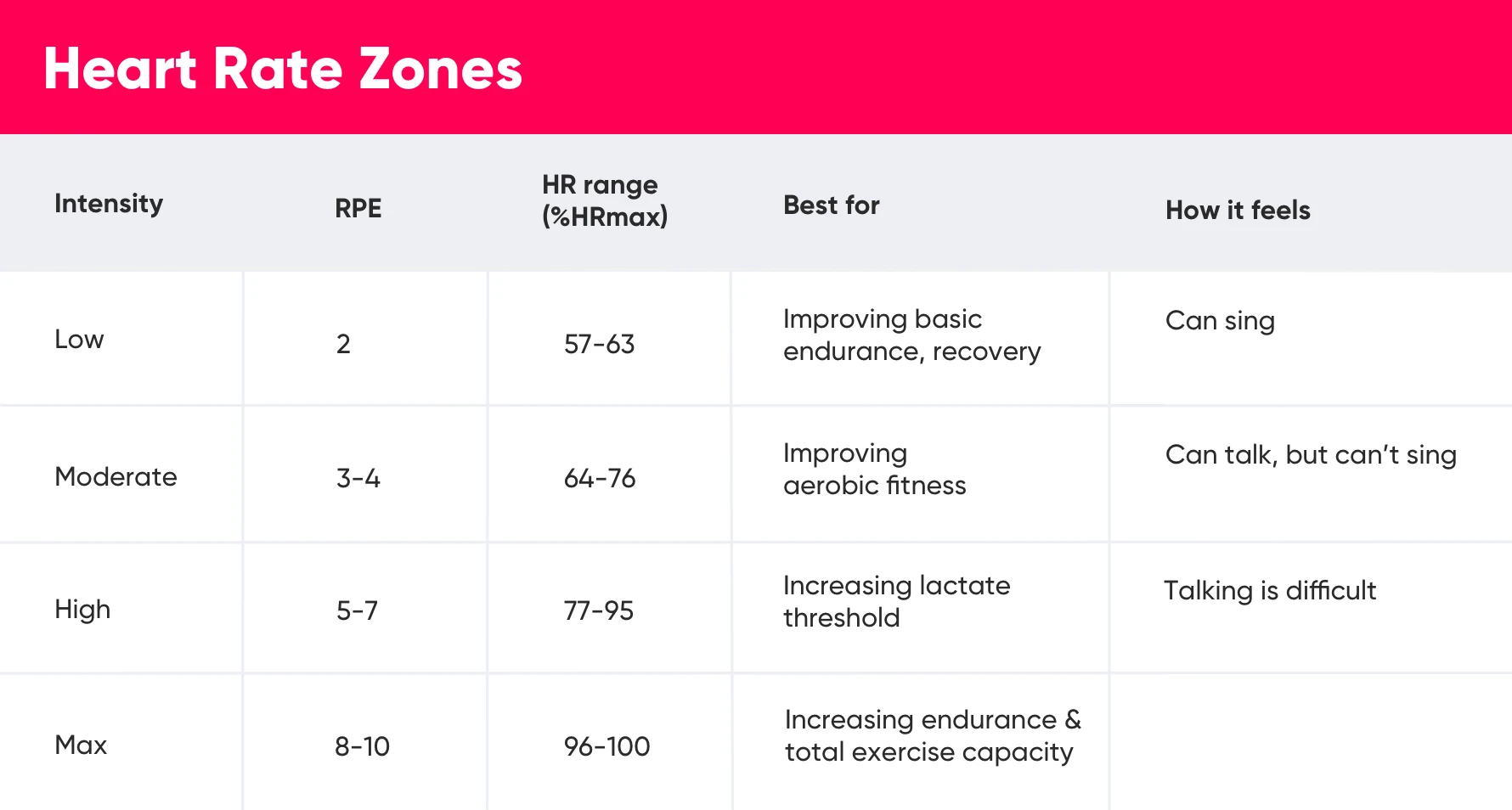How To Train With Heart Rate Zones

September 27, 2019

Fitness trackers or heart rate monitors can help track your activity and heart rate during your workouts. You might measure your heart rate if you need to exercise at a certain intensity to achieve specific health and fitness goals.
For example, if you’re doing fasted cardio, you might use a lower intensity training zone compared to when you’ve eaten.
Learn more:Can Fasted Cardio Make Your Workouts More Effective?
Here’s what you need to know about the different heart rate zones and how you can target each one to reach your fitness goals.
Why should you measure your heart rate?
When you exercise, you strengthen your muscles, including your heart. Just like the other muscles in your body, when you challenge your heart to work harder, it becomes stronger.
The more you push yourself during exercise, the more oxygen your muscles need to get energy. This means your heart pumps faster and harder!
Heart rate is measured in “beats per minute”.
Your resting heart rate (RHR) can indicate how physically fit you are. According to Mayo Clinic in the US, generally speaking, a lower resting heart rate means your heart is more efficient and suggests you have better cardiovascular fitness.
Harvard Health Publishing recommends measuring your resting heart rate first thing in the morning using your wrist to take your pulse. Start by holding out one of your hands with your palm facing up. Then, with your other hand, press your index and middle fingers together on your wrist at the base of your thumb until you feel a pulse. Count the number of beats in 15 seconds, and multiply that number by 4.
Depending on your fitness level, UNC cardiologist Christopher Kelly, MD, says that “a resting rate of 60 to 85 is typically the norm” for healthy adults.
Heart rate can be affected by stress, anxiety, age, air temperature and many other factors, so it can vary from day to day. If you have any concerns about your heart rate, it is best to seek advice from your doctor.
What does max heart rate (HRmax) mean and how can you estimate it?
As stated by Cleveland Clinic in the US, your maximum heart rate (HRmax) “is the highest heart rate achieved during maximal exercise” and can be used to calculate your target heart rate for exercise.
While a laboratory test will provide you with the most accurate result, there are a number of different methods you can use to calculate your HRmax.
One of the easiest ways you can calculate your HRmax as a beginner is by using the HUNT method. This formula is measured by multiplying your age by 0.64, then subtracting this number from 211.
An example for a 27-year-old would be: 211 - (27 x 0.64), so your estimated maximum heart rate will be 193.72 beats per minute (bpm).
This formula is just a guide. Sometimes people can record a heart rate slightly higher than this during very intense activity.

What are the heart rate zones?
Heart rate zones are a percentage range of your maximum heart rate, and according to Cleveland Clinic, they “let you know how hard your heart is working and what energy source you’re using — carbohydrates or fat. The higher your heart rate gets, the more you’re relying on glycogen from carbohydrates for fuel.”
Each heart rate zone is a measure of intensity and has a corresponding 0-10 scale or rate of perceived exertion (RPE). You should use both methods to subjectively assess how hard you are working to reach a target heart rate and certain fitness goals.
Learn more:How Rate Of Perceived Exertion (RPE) Can Maximise Your Training
As mentioned in a scientific report submitted to the Secretary of HHS by the 2018 Physical Activity Guidelines Advisory Committee in the US, the sing-talk test is the simplest tool used outside of a clinical setting to “help individuals self-regulate the [...] intensity of their aerobic physical activity.”.
It is important to consider that recommendations may differ for the percentage of maximal heart rate in each target workout zone across organisations and companies. The American College of Sports Medicine provides the following values:
Low-intensity 57-63% HRmax
When walking at a moderate to a brisk pace, your heart rate should be in the low-intensity zone, or about 110-122bpm if you are 27 years old.
Training at this intensity may help to improve blood flow and circulation and is a good way to start exercising if you’re a beginner or to help you move again if you’ve taken time off from exercise.
You should be able to carry on a conversation at this intensity and therefore sustain this zone for the longest amount of time.
This zone is ideal for warming up and cooling down before and after your workouts, and during low-intensity cardio.
Moderate-intensity 64-76% HRmax
The British Heart Foundation recommends at least 150 minutes of moderate-intensity exercise every week, which could include activities like cycling or dancing.
When training in this heart rate zone, you may feel slightly out of breath and find it a little harder to talk, but should still be able to maintain a conversation.
Training at a moderate intensity can increase your endurance, lung capacity and the efficiency of your cardiovascular system and according to the National Strength and Conditioning Association in the US can also help improve your ability to recover between training sessions.
For a 27-year old, this is around 123-147 bpm. Other activities that may help you achieve this intensity include jogging, hiking up a steep hill or swimming at a solid pace.
The Canadian Academy of Sports Nutrition confirms that on average, your body uses equal amounts of energy from fat and carbohydrate when training in this zone.
High-intensity 77-95% HRmax
Also known as your “anaerobic threshold training zone”, exercising at this intensity, the upper limit of your physical capacity, can increase your lactate threshold or your ability to work at a higher intensity before you begin to feel the “burn” — and therefore help you go harder for longer.
According to an article published by the University of New Mexico, “lactate threshold is the most consistent predictor of performance in endurance events [and] refers to the intensity of exercise at which there is an abrupt increase in blood lactate levels.”
For a 27-year old, this is a heart rate between 149-184bpm and can be achieved during activities like a high-intensity spin class or a running race.
In their Guidelines for Exercise Testing and Prescription, the American College of Sports Medicine recommends 75 minutes of vigorous-intensity aerobic activity each week.
Maximum effort 96-100% HRmax
Sometimes referred to as the “red zone”, you’ll usually only be able to sustain this level of effort for a short time, such as in an all-out sprint.
When you first start exercising, you might not be able to go hard enough to get into this zone — that’s normal!
For more advanced exercisers, you’ll ideally get into this zone at the toughest part of a HIIT workout.
For a 27-year old, this maximal heart rate zone will be 185-193bpm.

Use heart rate zones to target your training
As stated in the “Physical activity and exercise guidelines for all Australians” by the Department of Health in Australia, “doing any physical activity is better than doing none.” There is no hard evidence that suggests there is greater benefit from doing vigorous activity compared to lighter intensity activities.
If you have specific fitness goals, using heart rate zones or your perceived rate of exertion can help you focus your training and choosing a variety of training styles that range in intensity can help to influence a variety of health outcomes — aerobic exercise may help to improve cardio-respiratory fitness and strength training can help to increase muscle strength.
A recommendation that remains consistent around the world is to aim for at least 150 minutes of moderate-intensity exercise each week, or more for added health benefits.
Do you track your heart rate or rely on perceived exertion to monitor your training? Let us know in the comments!

A more empowered you starts with Sweat, and our editorial team is here to bring you the latest fitness tips, trainer recommendations, wellbeing news, nutritional advice, nourishing recipes and free workouts.
* Disclaimer: This blog post is not intended to replace the advice of a medical professional. The above information should not be used to diagnose, treat, or prevent any disease or medical condition. Please consult your doctor before making any changes to your diet, sleep methods, daily activity, or fitness routine. Sweat assumes no responsibility for any personal injury or damage sustained by any recommendations, opinions, or advice given in this article.
Fitness